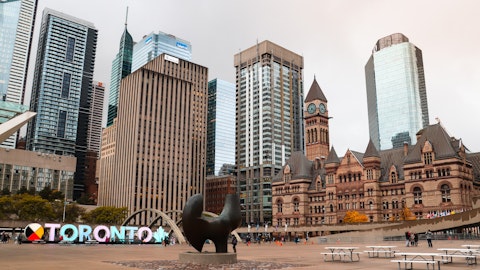We’ve created just a clear sense of accountability in the organization. We’ve created a detailed scorecards as well which really allow us to measure across a balanced portfolio results, but also stack the sites up against each other. So there’s a little bit of internal competitive tension that the organization is rising to. So it’s actually pretty simple stuff so far. We’ve also been rolling out our — as Rich mentioned earlier, OEMS work processes. We’re at early stages of that. But there is huge suction in the organization, and we’re seeing immediate benefits coming from that already. And I think you can expect even more of that as we go forward. These are really simple, well-designed processes that will create consistent work process across the organization and allow us to operate with excellence.
There’s no secret our Commerce City refinery was part of the challenge in the second half or the first half of last year and even into 2022 to some extent. We’ve made changes there to our leadership team. We’ve undertaken a reliability and recovery initiative led by our VP down in Commerce City. They’re doing a tremendous job. That work is sponsored by me. In fact, we have stewardship from them to me this afternoon on how that’s going. We do that monthly, and they’re making incredible progress in their journey. So I would say, more to come in that space, but we think we’ve made some fundamental shifts in just how we’re driving accountability in the organization.
Richard Kruger: John, this is Rich. I’d add one other thing to it, because I think it’s true not only in the Downstream, but in the Upstream. Last year, while we were going through a number of other changes, Dave and Peter, they realigned all — and I mentioned this on the last call, all of their operating sites to the same kind of organizational structure. So now whether it’s operations managers, maintenance managers, technical managers, we have networks nationwide of people who have the same jobs and the same accountabilities. So although — he referenced that we’ll show sites against each other. I think the other aspect of it, we’ve greatly enhanced the collaboration across sites. And even something as simple as we’ve said before, we went to one incentive scorecard for Suncor.
Suncor wins and loses as a team. in that collaboration, I see it not only across the Downstream or the Upstream between the Upstream and Downstream. And so these are not single things you point out. This was the solution, but it’s the aggregate. It’s the puzzle of connecting these pieces that gets a results-oriented high-performance culture, and that is exactly what we’re driving toward.
John Royall: That’s very helpful. And then second one is maybe just more of a housekeeping one for Kris. But you had a working capital headwind of about $380 million in 1Q. Can you talk about the drivers there? Is that mostly price? And then last year, you had a much larger headwind in 1Q, but you got a lot of it back in 2Q through 4Q. Should we expect to get any of that 1Q build back as we progress through the year?
Kristopher Smith: Yes. Thanks for that, John. Yes, you’re absolutely right, the way you just framed it. I mean Q1, primarily driven by higher sales volumes pricing. So that’s what we saw in the working capital kind of use of cash and that’s not unusual as well. We usually see a bit of a working capital build in Q1, particularly as we’re prepping for turnarounds. And then similarly, as we’re heading into Q2, we’re going to start to see inventories wind down as we’re supporting these turnarounds that we’ve been talking about. So I think the way you just described it. The good news is, from my perspective, is we didn’t see the large swing — that we saw in Q1 of 2023. And so that’s really what kind of the drivers behind what you saw in Q1 and then what — kind of what we should expect as we come out of Q2.
Operator: One moment for our next question, and that will come from the line of Patrick O’Rourke with ATB Capital Markets.
Patrick O’Rourke: It’s been a pretty comprehensive run-through a lot of the operational questions that I had. So maybe I’ll ask something a little bit broader and more philosophical. You’ve obviously done some horse trading of assets here. Fort Hills consolidating the working interest there being the biggest piece on asset sales. Just wondering, there’s been — there was some media reports about potentially opening things up again on the retail side. Maybe some broader commentary with respect to your views of the overall asset portfolio, potential M&A opportunities on sort of both sides of the ledger there. I know the focus has been operations and improvements in the mines and things are doing great, but on that front. But do you look at transactions in this environment?
Richard Kruger: Yes. Sure, Patrick. I’ll just comment. We look at all of our assets, all of the time in terms of their delivery of value today and what further potential they have across a range of market conditions. If you look at fundamentally who we are and what our core winning proposition, it’s this heavy integration between our Upstream and our Downstream assets that are fundamentally underpinned by large long-life Oil Sands resources. That’s the family photo. Now that doesn’t mean we have — we don’t have cousins and hands and uncles and stuff that are part of the family, but they’ve got to contribute. And so we look at all of our assets all the time. I feel quite good about our asset base. But that doesn’t mean we’re not always looking at.
Is there something worth more to someone else. Or is there something else out there that can enhance or add to our portfolio. So you’ve acknowledged a few things we’ve done here in the recent year or so, Fort Hills. The renewable power business and things like that, the North Sea assets. We’ll continue to look at that. I’m not signaling anything. I don’t have anything on the view screen right now, but that’s just what we do as we manage a portfolio.
Patrick O’Rourke: Okay. Great. And then maybe on the return of capital policy, I’m not sure if you’re able to forecast here at strip, but into the next hurdle at the $12 billion time frame potentially around that? And then thoughts with the structural improvements to the business that you’re making on the increasing free cash flow that those generate. How do you think about allocating that structural improvement between, say, dividends and the balance being the NCIB?
Richard Kruger: Yes. We will talk about this at length of the May 21st, but let me just comment a little bit. The current capital allocation framework with the tiers, I think it’s important — that was put in place what, Kris, 2021 or so. And things change over time. And I think I’ll just reiterate Kris’ point made a few minutes ago is when we look at our underlying performance of the business and our confidence in that business to deliver incremental cash, that’s different today than it was a few years ago. So as we look at capital allocation, I mean, we want to have a strong, resilient balance sheet. We want to continue to pay a reliable and growing dividend you from a sustaining capital, you take care of the assets you have, but we also look at what exactly does it take.
So all of those things are kind of works in motion. And what we plan to do on the 21st is kind of share that philosophy with you how we see our performance in the world we’re operating in today and what does that mean. So that’s a long answer to stay tuned.
Operator: One moment for our next question, and that will come from the line of Menno Hulshof with TD Cowen.
Menno Hulshof: I drop the call halfway to your answer, Dave, but I’ll be sure to pull the transcript. So on a — okay. Yes, that was just dead silence after the answer. But second question was the — on the replacement of OEMS, if I wrote that down correctly. The question, I guess, is how much is that going to cost? Do you see any risk in migrating to the new system? And how quickly do you expect that project to pay out?
Richard Kruger: Menno, I think any time you have changed, particularly that at an operation, you need to be very, very thoughtful about your management of change process, as you go from one way of doing things to another. And I’m looking at down the table here at Shelley, Peter and Dave. And they meet comprehensively, I know they meet monthly on this very topic. But I also know, since their offices are right down the hall, they talk about this daily. So we wanted to be very thoughtful as we do it. So we don’t drop anything in the process. And I would say we feel good — quite good about that. The cost has been incurred. The cost is people’s time to collaborate and develop the symptoms and the vision of where we are and where we want to go.





